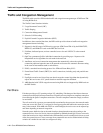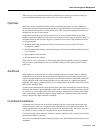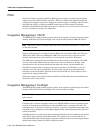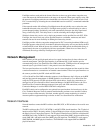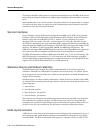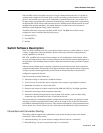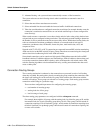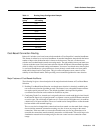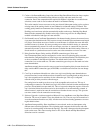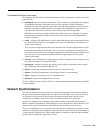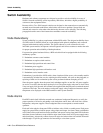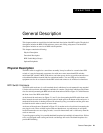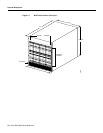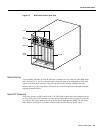
1-22 Cisco BPX 8600 Series Reference
Switch Software Description
• Cache vs. On-Demand Routing–In previous releases Hop-Based Route Selection always requires
on-demand routing. On-demand routing initiates an end-to-end route search for every
connection. Due to the computation time required for Dijkstra’s algorithm in cost-based route
selection, a route cache is used to reduce the need for on-demand routing.
This cache contains lowest cost routes as they are selected. Subsequent routing cycles use these
existing routes if the routing criteria are met. Otherwise on-demand routing is initiated. This
caching greatly benefits environments where routing criteria is very similar among connections.
Enabling cost-based route selection automatically enables cache usage. Enabling Hop-Based
Route Selection automatically disables cache usage. Cache usage can also be independently
enabled or disabled for both types of route selection.
• On-Demand Lowest Cost Route Determination–On-demand routing chooses the current lowest
cost route to the destination node. This lowest cost route is bounded by the maximum route length
of 10 hops. If more than one route of similar cost and distance is available, the route with most
available resources is chosen. No route grooming occurs after the initial routing. A connection
does not automatically reroute if its route cost changes over time. A connection also does not
automatically reroute if a lower cost route becomes available after the initial routing. However, a
forced reroute or a preferred route can be used to move the connection to a lower cost route.
• Delay Sensitive Routes–Delay sensitive IPX/IGX connection types (Voice and
Non-Timestamped Data) may be configured to use the worst case queueing delay per trunk,
rather than the configured trunk cost, in the lowest-cost route determination. The trunk delay acts
as the cost attribute in the Dijkstra algorithm. The default mode for the delay sensitive
connections is to use the trunk cost. All other connection types always use the trunk cost in the
route determination.
AutoRoute currently does not use the worst case end-to-end queueing delay in route selection for
delay sensitive BPX connection types (ATM CBR). cost-based route selection does not change
this.
• Cost Cap–A maximum allowable cost value (cost cap) is used during route determination to
prevent selection of a route which exceeds an acceptable cost. For routing based on delay, the cost
cap is the acceptable end-to-end delay for the connection type. This cap is configured
network-wide per delay sensitive connection type.
For routing based on trunk cost, the cost cap is the acceptable end-to-end cost. This cap is
configured per connection. The default cost cap is 100, which is derived from the maximum hops
per route (10) and default cost per trunk (10). The cost cap can be changed at any time. If the cost
cap is decreased below the current route cost, the connection is not automatically rerouted. A
manual reroute is required to route the connection to fit under the new cost cap. This gives the
user more control over the connection reroute outage.
• Software Upgrades–A software upgrade to Release 9.0 sets AutoRoute to use Hop-Based Route
Selection. The cost of all trunks is set to the default cost (10). The cost cap of all connections is
set to the maximum allowable cost (100). All other new cost-based routing parameters are set to
regular default values.
• AutoRoute Interoperability–Since AutoRoute is source-based, nodes can interoperate using
different route selection algorithms. The originating node computes the full end-to-end route
based on its own knowledge of the network topology. The route is then passed to the subsequent
nodes on the route. This source routing allows a mix of Cost-Based and Hop-Based Route
Selection to run in a network.



